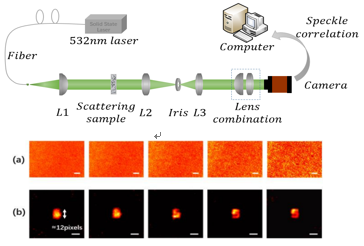Speckle autocorrelation imaging is a new emergent imaging technique through scattering media, with its main advantages in simple experimental setup, single-shot fast detection and non-invasion. The prerequisite of speckle autocorrelation imaging is optical memory effect, whose range determines the field of view (FOV) of imaging. The memory effect range is inversely proportional to the thickness of a medium. For real scattering media, such as biological tissues, the memory effect range approaches zero once the thickness is larger than 1 mm, the limited FOV restrains the applications of speckle autocorrelation imaging to thick media.
Recently, a team from Shanghai Institute of Optics and Fine Mechanics, Chinese Academy of Sciences, in collaboration with researchers in Hongkong Polytechnic University, had proposed a method to extend the memory effect range by spatial filtering, consequently resulting in an expansion of FOV of speckle autocorrelation imaging. The paper was published in Optics Letters.
In the study, based on previous work, the researchers found that less scattered light had larger memory effect range, and it remained dominant in forward direction. Therefore, they proposed the spatial filtering method to select ballistic and less scattering light to expand the memory effect range.
Compared with time gating, spatial filtering is a simple passive way with no critical requirements in implementation. In their experiment, a 4f lens system was applied as the spatial filter. By changing the diameter of an iris in the 4f system, low frequency less scattered light could be filtered out. Simulations based on a multiple random phase mask model and experimental results were presented to validate the effectiveness of the spatial filtering. Also, the expansion of the imaging FOV with decreased filtering bandwidth was demonstrated experimentally.
In conclusion, the research provides a simple but effective spatial filtering way to expand the memory effect range. It can be easily realized and integrated in the design of an optical system. Besides the speckle autocorrelation imaging, its potential benefits can be extended to a wide range of optical imaging and manipulation techniques through scattering media.

Experimental setup of speckle autocorrelation imaging with the 4f-configuration spatial filter and the results-the recorded speckle patterns and corresponding reconstruction images at different filter bandwidths. (Image by SIOM)
Article website:
https://doi.org/10.1364/OL.44.005997
Contact:
Mr. CAO Yong
General Administrative Office
Shanghai Institute of Optics and Fine Mechanics, CAS
Email: caoyong@siom.ac.cn